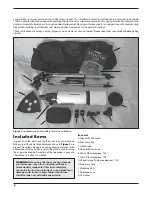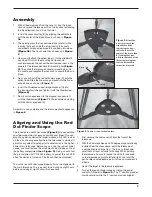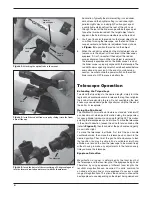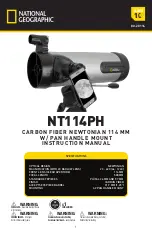
The StarBlast 102mm also excels for nighttime viewing, enabling
you to see hundreds of craters on the Moon, Jupiter and its four
major moons, the rings of Saturn, and much more! If you take
the telescope to a location away from city lights (the darker, the
better), you will be able to spot most of the famous “M objects,”
or Messier objects, which include open star clusters, globular
star clusters, gaseous nebulas, and even galaxies outside our
own Milky Way galaxy. You’ll need a star map or a planisphere
(the Orion Star Target plansiphere is a great one) and some
patience, but the rewards are endless.
Best Targets
Best night sky targets from the city:
•
The Moon
•
Venus
•
Jupiter
•
Saturn
Best targets from rural locations (everything
above, plus):
•
Great Nebula in Orion
– a spectacular glowing cloud of
gas in Orion’s sword; this is a “stellar maternity ward,” a
place where new stars are forming.
•
Summer Milky Way
– the StarBlast is well suited to
scanning the Milky Way to “discover” dozens of star
clusters.
•
Pleiades (M45)
– a bright open star cluster
•
Andromeda Galaxy (M31)
– the brightest external galaxy
•
Double Cluster in Perseus
•
M11, M6 & M7
– three bright summer star clusters
•
Beehive Cluster
– a big, open star cluster in the spring
sky
•
Great Cluster in Hercules (M13)
– a wonderful globular
star cluster, spring & summer
•
M22
– another grand globular star cluster in Sagittarius,
a summer constellation
“Seeing” and Transparency
Atmospheric conditions vary significantly from night to night.
“Seeing” refers to the steadiness of the Earth’s atmosphere at
a given time. In conditions of poor seeing, atmospheric turbu-
lence causes objects viewed through the telescope to “boil.” If
you look up at the sky and stars are twinkling noticeably, the
seeing is poor and you will be limited to viewing at lower magni-
fications. At higher magnifications, images will not focus clearly.
Fine details on the planets and Moon will likely not be visible.
In conditions of good seeing, star twinkling is minimal and
images appear steady in the eyepiece. Seeing is best overhead,
worst at the horizon. Also, seeing generally gets better after mid-
night, when much of the heat absorbed by the Earth during the
day has radiated off into space.
Especially important for observing faint objects is good “trans-
parency”—air free of moisture, smoke, and dust. All tend to scat-
ter light, which reduces an object’s brightness. Transparency is
judged by the magnitude of the faintest stars you can see with
the unaided eye (5th or 6th magnitude is desirable).
Cooling the Telescope
All optical instruments need time to reach “thermal equilibri-
um.” The bigger the instrument and the larger the temperature
change, the more time is needed. Allow at least 30 minutes for
your telescope to acclimate to the temperature outdoors before
you start observing with it.
Let Your Eyes Dark-Adapt
Don’t expect to go from a lighted house into the darkness of the
outdoors at night and immediately see faint nebulas, galaxies,
and star clusters—or even very many stars, for that matter. Your
eyes take about 30 minutes to reach perhaps 80% of their full
dark-adapted sensitivity. As your eyes become dark-adapted,
more stars will glimmer into view and you’ll be able to see fainter
details in objects you view in your telescope.
To see what you’re doing in the darkness, use a red-filtered
flashlight rather than a white light. Red light does not spoil your
eyes’ dark adaptation like white light does. A flashlight with a red
LED light is ideal. Beware, too, that nearby porch, streetlights,
and car headlights will hinder your night vision.
Using the MoonMap 260
Included with your StarBlast 102mm refractor telescope is
Orion’s exclusive MoonMap 260 (I). It depicts the locations
and names of over 260 features on the Moon such as craters,
mountains, valleys, "seas" and more. It is a great tool for begin-
ning astronomers. This detailed map will even show you where
various spacecraft from past space missions have landed on the
Moon's surface!
The great thing about the Moon is that its phase changes every
night. Focus your attention on the border between the illumi-
nated and dark portions or the surface, called the “terminator”.
Shadows cast along the terminator help to reveal the rugged
relief of the landscape. Note that the worst time to view the
Figure 9.
The red dot finder scope has vertical and (inset) horizontal
adjustment knobs for aligning it with the telescope.
Power switch
Vertical knob
Plastic
tab
Horizontal knob
6

























